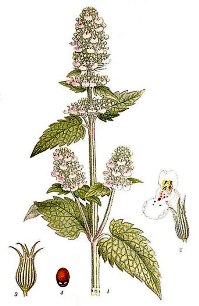Catnip History: Name Origins
(Nepeta cataria, Linn.)

We start our brief catnip history with the origin of its scientific name. The name Nepeta is derived from the Etruruan city of Neptic where the plant was said to be prominently grown. The French call catnip herbe aux chats and often made a tea from catnip prior to the arrival of Chinese teas.
Catnip was used as an ointment for piles, scabs, scurf and other skin ailments. And like so many other herbs that we have researched, catnip is listed as being effective against flatulence.
Some believe that, when chewed, catnip root can make a person fierce and quarrelsome. Catnip history includes the legend of a hangman, who had trouble finding the courage to conduct his profession. He medicated himself with catnip in order to complete his task.
In yet another contradiction among our reference materials, catnip is listed as an effective sedative, particularly in children.
And still a third source on catnip history, mentioned catnip tea being given to people who were ill. It was said to produce perspiration without increasing body heat which made it useful for the treatment of colds and fevers.
Catnip & Animals
I suppose this makes sense that humans might react differently to catnip after observing how our own cats (all females) have reacted to catnip. One, a Siamese and Himalayan mix, rolled in the dried leaves, licked any stuffed toys that contained it, and would appear to be drunk from the experience. Another cat would become highly aggressive (we had to keep catnip away from her) and a third simply had no interest.
One of resources suggested genetics as the cause of people and animals reacting differently to catnip. Our current Siamese sisters will casually approach catnip, lick the leaves or toy, roll around a bit and that’s pretty much it – neither one generally gets too excited. Our two pound baby tabbies were the ones who were indifferent or became aggressive; both reactions being atypical of that of most cats.
There is an old saying about cat mint, “If you set it the cats will eat it: if you sow it the cats won’t know it.” The attraction to the herb for cats stems from the fact its scent is similar to pheromones of cats of the opposite sex. The scent is also similar to mint which is why catnip is often called cat mint.
In a small irony, rats absolutely detest catnip which can be used as an effective barrier against them.
Additional Catnip Information.
Our Herb Garden also has guides on Growing Catnip and Catnip Companion Planting.
“If you set it, the cats will GET it. If you sow it, the cats won’t know it.”